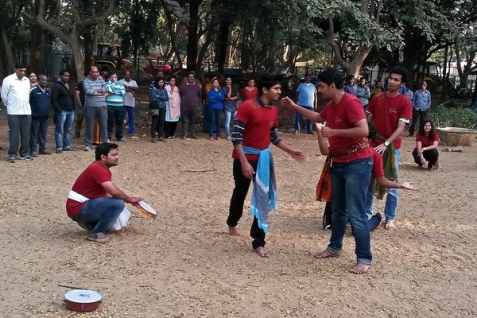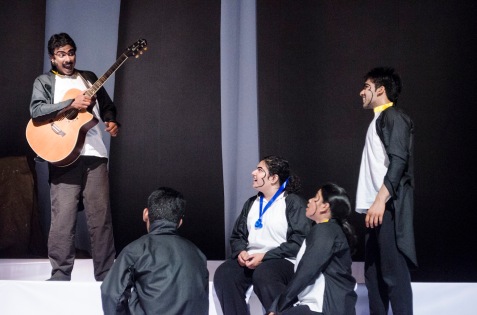Rana and I wanted to be there; first day, first show. We landed up at the matinee instead, thanks to a meeting. I can’t resist quoting Murphy here, “A meeting is an event at which the minutes are kept and the hours are lost.” But hey, we still managed to be there on the first day. It wasn’t a movie, it wasn’t a play, it wasn’t a concert. Or was it everything? 🙂
I’ll come to that show in a while. I have to tell you that having grown up with Tintin and Tom & Jerry, singing the Looney Tunes, “reading” The Jungle Book with a “Tinkle” in my eye, I loved cartoons, naturally. More cartoons entertained me, enlightened me; be it those of R K Laxman, Bill Waterson or Maya Kamath.
 One of my favorites today is Rohan Chakravarty, a.k.a Toonie, cartoonist and conservationist. Yes, these two words can and do go together in this case! “Behind every successful male, there is a female” – is true in Rohan’s case also. He watched a gorgeous tigress bathing in a pool at Nagzira Wildlife Sanctuary. That was the beginning of many wild things to come.
One of my favorites today is Rohan Chakravarty, a.k.a Toonie, cartoonist and conservationist. Yes, these two words can and do go together in this case! “Behind every successful male, there is a female” – is true in Rohan’s case also. He watched a gorgeous tigress bathing in a pool at Nagzira Wildlife Sanctuary. That was the beginning of many wild things to come. 
It is his exhibition that we were at, for the matinee show on September 13, 2014.
Venue- Indian Cartoon Gallery, No.1, Midford House, Midford Garden, near Kids Kemp, Trinity Circle, Bangalore- 01
Date- 13th to 27th September, 2014.
Timings- 10 a.m. to 6 p.m.
I requested our friend and award-winning artist, Rohan, to share a few insights with us. (All artwork below is property of Rohan Chakravarty).

Since you are a foodie, let me begin with asking you about your experience of having roast socks for dinner at Eaglenest! (For those of you curious to know more, here are excerpts from the Arunachal Bird Festival).
Hahaha! Thank you first of all, Sugandhi, for choosing to feature me on Aranya Parva. I was in search of the Wedge-billed Wren Babbler near Sessni Camp at Eaglenest WLS, and there was a huge puddle which the guides called ‘Hathinaala’ ahead of us. Soujanyaa, the younger and the more acrobatic among us jumped right across it, but I being the clumsier of the lot, had to get my shoes wet (also, I missed getting the bird). Thankfully, Ushma who is studying hornbills in Eaglenest had a fire ready for her khichdi, which I simultaneously used to dry my socks. Ushma saved me from a definite frostbite that evening. I think I owe her roast socks for dinner some day.
 Congratulations for Green Humour becoming the first cartoon and comic strip series from India to be distributed by an international syndicate, Gocomics. What issues would you like to highlight at Gocomics?
Congratulations for Green Humour becoming the first cartoon and comic strip series from India to be distributed by an international syndicate, Gocomics. What issues would you like to highlight at Gocomics?
Thank you! Gocomics has an essentially American readership and while I am always trying to portray issues concerning wildlife all around the world, not being limited by geographical bounds, I would like the west to be acquainted with both facts about animals from India, as well as the conservation threats they face, through my Gocomics page.
Any cartoon (yours or someone else’s) that would aptly describe why mathematics haunts you? 🙂

I did this cartoon for a slideshow design firm from the USA, but if you replace ‘Powerpoint Presentation’ with ‘Mathematics lesson’ in the cartoon, it pretty much sums up the effect math had on me as a kid.

The notes that accompany your cartoons are well-researched. With mathematics haunting you, how do you still manage to read scientific publications, especially with having a scientist for a brother?
I never read the oh-so-scientific bits, I like to stick to the romance of it! My brother and I are constantly sharing notes on birds and other creatures we’re constantly on the lookout for, being fellow-twitchers. The fact that he isn’t one of those stats-obsessed ogres (no offence!) but a natural history enthusiast also helps.
 Why is the Jungle Crow so special to you (although you don’t really enjoy the constant cawing of a crow)?
Why is the Jungle Crow so special to you (although you don’t really enjoy the constant cawing of a crow)?
Firstly, the Jungle Crow in my view is exceptionally handsome. I’m sure you’ve observed murders of crows from your balcony several times. The very disdain with which they speak about us humans amongst themselves is what makes me respect them. They are shrewd, rowdy and it seems to me that they’re always conspiring to take over the planet. If the throne of the earth rightfully belongs to a single animal, it should be the crow! And if you’ve ever happened to compare the cawing of a crow to that of a human baby, you’ll realize how melodious the crow actually is!

How was vectoridae born and where do you plan to go with it?
The conception of Vectoridae was actually impromptu. The beauty of vector illustrations is that they can be reproduced on any medium, in any size, with no distortion or loss of quality. I was looking at stock images from several artists around the world, on wildlife, just to check if species-specific illustrations were available. While the more famous ones (Pandas, tigers, blue whales) find representation in all kinds of media, vector illustrations of, let’s say, a Black-bearded Tomb Bat, are impossible to find unless someone’s really willing to sit, read, gather images and prepare illustrations of these animals who get neither the daylight nor the limelight! That’s when I said to myself, “this must begin right away… How about tomorrow?”
With Vectoridae, I hope to contribute vector illustrations to as many conservation-related media as I can. Since the images are royalty free and available for a lifetime usage, I am hoping it would strike a chord with scientists and conservationists alike.
A caricatured map of Pakke Tiger Reserve must have been so challenging! What were your most memorable moments from that project?
I must really thank my friend Nandini Velho, who is doing her PhD on the impacts of logging around Eaglenest and Pakke, for introducing me to Arunachal Pradesh, India’s ‘Land of the Rising Sun’. I’ve never really visited Pakke, so that remains a regret I hope to remedy in the near future. My most memorable moment with respect to the project was the final result- seeing pictures of kids from Seijusa at the Pakke interpretation centre, looking out for little details in the map. Nandini informed that one of the shyest kids who never communicated, suddenly erupted with his list of favourite animals from the map on seeing it. I think representing animals in a delightful manner has a profound impact on young minds, and evokes compassion. 
Which are your favorite movies and books in the humor genre?
 I’ll begin with movies. King of Comedy (Martin Scorsese) cannot be categorized essentially as a humorous movie, but I absolutely love the dark humour in it. I also love the work of Woody Allen, especially Annie Hall. Amelie, again not a comedy, but full of subtle, gentle and tasteful humour remains my all-time favourite film. Closer home, my favourites would be Hrishikesh Mukherjee’s ‘Angoor’ and Rajkumar Santoshi’s Andaz Apna Apna.
I’ll begin with movies. King of Comedy (Martin Scorsese) cannot be categorized essentially as a humorous movie, but I absolutely love the dark humour in it. I also love the work of Woody Allen, especially Annie Hall. Amelie, again not a comedy, but full of subtle, gentle and tasteful humour remains my all-time favourite film. Closer home, my favourites would be Hrishikesh Mukherjee’s ‘Angoor’ and Rajkumar Santoshi’s Andaz Apna Apna.
As far as books are concerned, I can go on and on about the cartoonists I admire. Gary Larson’s ‘Far Side’ collections, Patrick McDonnell’s Mutts, Calvin and Hobbes by Watterson and Scott Adams’ Dilbert are a few of these. Other than that, I love reading Gerald Durrell and the work of Edward Hamilton Aitkien, who blend humour and natural history like nobody can!
What message do you want to provide people and children through your artwork ?
“Hey, ever even imagined that you share space with these marvellous creatures?!”
——
A big thanks to Rohan for giving us an insight into his wild life. To know about what prompted him to take this career path, do read Green Humour and the links in the references section.
And make sure you don’t miss ‘Wildlife the Toonie Way‘, an exhibition-cum-sale of wildlife caricatures, by Green Humour in association with The Indian Institute of Cartoonists.
Watch wildlife in a fresh, new plumage!
Sugandhi
References:
 Bangalore Little Theatre (BLT) is back with yet another production, an original English language adaptation of 1950’s movie, Maya Bazaar. My father was a die-hard fan of the movie, and naturally, we watched it – not once, but several times. The original was in Telugu, a language I don’t understand much, but the movie had such a connection with its audience, we just connected with it. But it was then. Today’s audience cannot go ga-ga over S V Ranga Rao’s magic, or N T Rama Rao’s style or Relangi’s tomfoolery. This is exactly what drove BLT’s Sridhar Ramanathan to present the story in a modern context.
Bangalore Little Theatre (BLT) is back with yet another production, an original English language adaptation of 1950’s movie, Maya Bazaar. My father was a die-hard fan of the movie, and naturally, we watched it – not once, but several times. The original was in Telugu, a language I don’t understand much, but the movie had such a connection with its audience, we just connected with it. But it was then. Today’s audience cannot go ga-ga over S V Ranga Rao’s magic, or N T Rama Rao’s style or Relangi’s tomfoolery. This is exactly what drove BLT’s Sridhar Ramanathan to present the story in a modern context. What an adaptation! Dang, I cannot reveal anything! Because you must watch it yourself to enjoy the production in all its glory. Superb comic timing, fantastic connections with current issues, and
What an adaptation! Dang, I cannot reveal anything! Because you must watch it yourself to enjoy the production in all its glory. Superb comic timing, fantastic connections with current issues, and  great performances. It is hard to pick a favorite, because everybody gave his/her 100% – including the percussionist sitting in the corner without a spotlight on him. But I cannot resist – I have to say that I absolutely loved the bird – the actor brought the bird to life, in looks and behaviour. My other favorite characters were Hidimbi, Ghatu and Lakshmana – had he been around, SVR would have joined the chorus of his evergreen song, this time in English, going “ta ding ta ding ta ding ding” 😀
great performances. It is hard to pick a favorite, because everybody gave his/her 100% – including the percussionist sitting in the corner without a spotlight on him. But I cannot resist – I have to say that I absolutely loved the bird – the actor brought the bird to life, in looks and behaviour. My other favorite characters were Hidimbi, Ghatu and Lakshmana – had he been around, SVR would have joined the chorus of his evergreen song, this time in English, going “ta ding ta ding ta ding ding” 😀































































